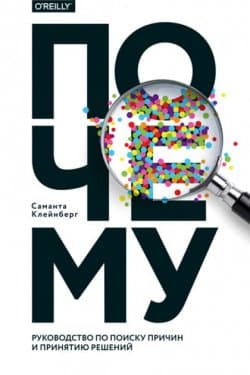Почему - Саманта Клейнберг (2017)
-
Год:2017
-
Название:Почему
-
Автор:
-
Жанр:
-
Язык:Русский
-
Страниц:160
-
Рейтинг:
-
Ваша оценка:
Автор показывает, что такое причинно-следственная связь, поясняет, почему в ее определении мы часто ошибаемся, как можно принимать верные решения. Благодаря этой книге вы научитесь анализировать информацию, выявлять причинно-следственные связи, объединять прошлое, предсказывать будущее.
Книга будет интересна философам, аналитикам, экономистам, медикам, юристам, начинающим ученым.
Почему - Саманта Клейнберг читать онлайн бесплатно полную версию книги
Rothman, K. J. (1976). Causes. American Journal of Epidemiology, 104(6):587–592. Reprinted in 141(2), 1995.
Rothman, K. J. (1990). No Adjustments Are Needed for Multiple Comparisons. Epidemiology, 1(1): 43–46.
Rothman, K. J. and Greenland, S. (2005). Causation and Causal Inference in Epidemiology. American Journal of Public Health, 95(S1): S144–S150.
Rothwell, P. M. (2005). External validity of randomised controlled trials: “To whom do the results of this trial apply?” The Lancet, 365(9453): 82–93.
Russell, B. (1912). On the Notion of Cause. Proceedings of the Aristotelian Society, 13(1912–1913): 1–26.
Russo, F. (2006). The Rationale of Variation in Methodological and Evidential Pluralism. Philosophica, 77(1): 97–124.
Russo, F. and Williamson, J. (2007). Interpreting Causality in the Health Sciences. International Studies in the Philosophy of Science, 21(2): 157–170.
Salganik, M. J., Dodds, P. S., and Watts, D. J. (2006). Experimental Study of Inequality and Unpredictability in an Artificial Cultural Market. Science, 311(5762): 854–856.
Sandvei, M., Mathiesen, E., Vatten, L., Müller, T., Lindekleiv, H., Ingebrigtsen, T., NjØlstad, I., Wilsgaard, T., LØchen, M.-L., Vik, A., et al. (2011). Incidence and mortality of aneurysmal subarachnoid hemorrhage in two Norwegian cohorts, 1984–2007. Neurology, 77(20): 1833–1839.
Sato, E., Furuta, R. A., and Miyazawa, T. (2010). An Endogenous Murine Leukemia Viral Genome Contaminant in a Commercial RT-PCR Kit is Amplified Using Standard Primers for XMRV. Retrovirology, 7(1): 110.
Saunders System Birmingham Co. v. Adams (1928). 217 Ala. 621, 117 So. 72.
Scheines, R. (1997). An Introduction to Causal Inference. In V. R. McKim and S. P. Turner (eds.), Causality in Crisis, pp. 185–199. University of Notre Dame Press, Notre Dame, IN.
Schlottmann, A. (1999). Seeing It Happen and Knowing How It Works: How Children Understand the Relation Between Perceptual Causality and Underlying Mechanism. Developmental Psychology, 35(5): 303–317.
Schlottmann, A., Allen, D., Linderoth, C., and Hesketh, S. (2002). Perceptual Causality in Children. Child Development, 73(6): 1656–1677.
Schlottmann, A., Ray, E. D., and Surian, L. (2012). Emerging perception of causality in action-and-reaction sequences from 4 to 6 months of age: Is it domain-specific? Journal of Experimental Child Psychology, 112(2): 208–230.
Schlottmann, A. and Shanks, D. R. (1992). Evidence for a distinction between judged and perceived causality. The Quarterly Journal of Experimental Psychology, 44(2): 321–342.
Schoenfeld, J. D. and Ioannidis, J. P. (2013). Is everything we eat associated with cancer? A systematic cookbook review. The American Journal of Clinical Nutrition, 97(1): 127–134.
Schulz, K. F. and Grimes, D. A. (2002). Blinding in randomised trials: Hiding who got what. The Lancet, 359(9307): 696–700.
Schulz, L. E., Gopnik, A., and Glymour, C. (2007). Preschool children learn about causal structure from conditional interventions. Developmental Science, 10(3): 322–332.
Schwarz, G. (1978). Estimating the Dimension of a Model. The Annals of Statistics, 6(2): 461–464.
Scriven, M. (1966). Causes, connections and conditions in history. In W. H. Dray (ed.), Philosophical Analysis and History, pp. 238–264. Harper & Row, New York.
Seok, J., Warren, H. S., Cuenca, A. G., Mindrinos, M. N., Baker, H. V., et al. (2013). Genomic responses in mouse models poorly mimic human inflammatory diseases. Proceedings of the National Academy of Sciences, 110(9): 3507–3512.
Shalizi, C. R. and Thomas, A. C. (2011). Homophily and Contagion Are Generically Confounded in Observational Social Network Studies. Sociological Methods Research, 40(2): 211–239.
Shanks, D. R. (1985). Forward and backward blocking in human contingency judgement. The Quarterly Journal of Experimental Psychology, 37(1): 1–21.
 Почему они не работают? Новый взгляд на мотивацию сотрудников Сьюзен Фаулер
Почему они не работают? Новый взгляд на мотивацию сотрудников Сьюзен Фаулер
 Королевство Аманда Стивенс
Королевство Аманда Стивенс
 Почему Саманта Клейнберг
Почему Саманта Клейнберг
 Момент истины. Почему мы ошибаемся, когда все поставлено на карту, и что с этим делать? Сайен Бейлок
Момент истины. Почему мы ошибаемся, когда все поставлено на карту, и что с этим делать? Сайен Бейлок
 Почему. Руководство по поиску причин и принятию решений Саманта Клейнберг
Почему. Руководство по поиску причин и принятию решений Саманта Клейнберг
 Здравый смысл врет. Почему не надо слушать свой внутренний голос Уоттс Дункан
Здравый смысл врет. Почему не надо слушать свой внутренний голос Уоттс Дункан

 Пир теней
Пир теней  Князь во все времена
Князь во все времена  Когда порвется нить
Когда порвется нить  Пока я здесь
Пока я здесь 



